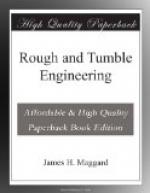Q. What would you do after being bothered in this
way?
A. Clean out the-boiler and get better water if possible.
Q. How would you manage your pumps while the water was foaming. A. Keep them running full.
Q. Why?
A. In order to make up for the extra amount of water
going
out with the steam.
Q. What is “cushion?”
A. Cushion is steam retained or admitted in front
of the
piston head at the finish of stroke, or when the engine
is on
“center.”
Q. What is it for? A. It helps to overcome the “inertia” and momentum of the reciprocating parts of the engine, and enables the engine to pass the center without a jar.
Q. How would you increase the cushion in an engine?
A. By increasing the lead.
Q. What is lead?
A. It is the amount of opening the port shows on
steam end
of cylinder when the engine is on dead center.
Q. Is there any rule for giving an engine the proper
lead?
A. No.
Q. Why not?
A. Owing to their variation in construction, speed,
etc.
Q. What would you consider the proper amount of lead, generally. A. From I/32 to I/I6.
Q. What is “lap?”
A. It is the distance the valve overlaps the steam
ports when
in mid position.
Q. What is lap for?
A. In order that the steam may be worked expansively.
Q. When does expansion occur in a cylinder?
A. During the time between which the port closes
and the
point at which the exhaust opens.
Q. What would be the effect on an engine if the exhaust opened too soon? A. It would greatly lessen the power of the engine.
Q. What effect would too much lead have.
A. It would also weaken the engine, as the steam
would
enter before the piston had reached the end of the
stroke, and
would tend to prevent it passing the center.
Q. What is the stroke of an engine?
A. It is the distance the piston travels in the cylinder.
Q. How do you find the speed of a piston per minute? A. Double the stroke and multiply it by the number of revolutions a minuet. Thus an engine with a 12 inch stroke would travel 24 inches, or 2 feet, at a revolution. If it made 200 revolutions a minute, the travel of piston would be 400 feet a minute.
Q. What is considered a horse power as applied to an engine? A. It is power sufficient to lift 33,000 pounds one foot high in one minute.
Q. What is the indicated horse power of an engine?
A. It is the actual work done by the steam in the
cylinder as shown by an indicator.
Q. What is the actual horse power?
A. It is the power actually given off by the driving
belt and
pulley.
Q. How would you find the horse power of an engine? A. Multiply the area of the piston by the average pressure, less 5; multiply this product by the number of feet the piston travels per minute; divide the product by 33,000; the result will be horse power of the engine.




